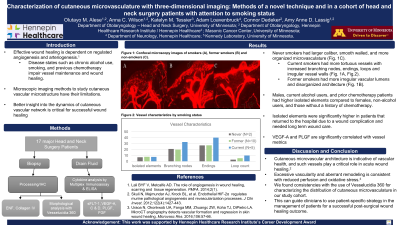Clinical Research
(CR-001) Characterization of cutaneous microvasculature with three-dimensional imaging: Methods of a novel technique and in a cohort of head and neck surgery patients
Friday, April 28, 2023
7:15 PM - 8:30 PM East Coast USA Time

Anna Wilson, BSc – Research Coordinator, Hennepin Healthcare Research Institute; Adam Loavenbruck, MD/MS – Neurologist, Hennepin Healthcare; Amy Anne Lassig, MD/FACS – Otolaryngologist, Hennepin Healthcare Research Institute
Introduction: The complex process of wound healing including angiogenesis and vessel maintenance are disrupted by co-morbidities. This study explored a new method to characterize cutaneous microvasculature; and determined the associations between baseline vessel characteristics and post-operative wound healing outcomes.
Methods: We prospectively enrolled a cohort of adult major head and neck surgery patients. Patient demographics and post-operative outcomes were recorded. A full thickness cutaneous biopsy from the inferior surgical skin flap of the neck incision was obtained at the time of surgery. Tissue was fixed for immunohistochemistry and immunolocalized for the expression of collagen IV antibodies along with secondary fluorophore-conjugated antibodies in preparation for confocal microscopy. In 3-D sections vesselucidia 360 software was used to morphologically characterize the cutaneous vasculature by tracing of collagen IV-stained vessels. Morphological vessel metrics were analyzed including: isolated elements, branching nodes, endings, loop count, total length, total volume, and total surface area. Vessel characteristics and patient characteristics were evaluated for associations. Statistical analyses were performed using R version 3.6.1 and SAS version 9.4; a p-value of 0.05 was considered significant.
Results: 17 subjects were enrolled into this cohort. Males, current alcohol users, and prior chemotherapy patients had a trend toward higher isolated elements. Vessel metrics were also found to be associated with wound care outcomes. Isolated elements were significantly higher in patients that returned to the hospital due to a wound complication (p=0.035), needed long-term wound care (p=0.012), and had other complications (p=0.019) and approached significance for patients who were later admitted into an inpatient facility post-discharge and had a post-operative wound infection.
Discussion: Cutaneous microvascular architecture is indicative of vascular health, and such vessels play a critical role in acute wound healing. Vesselucida software is an innovative tool for characterizing cutaneous vasculature, and in this study, we found that the number of isolated elements at baseline was associated with postoperative wound complications. Such analyses allow clinicians and scientists to better understand the role that microvascular structure plays in ensuring successful acute wound healing.
Methods: We prospectively enrolled a cohort of adult major head and neck surgery patients. Patient demographics and post-operative outcomes were recorded. A full thickness cutaneous biopsy from the inferior surgical skin flap of the neck incision was obtained at the time of surgery. Tissue was fixed for immunohistochemistry and immunolocalized for the expression of collagen IV antibodies along with secondary fluorophore-conjugated antibodies in preparation for confocal microscopy. In 3-D sections vesselucidia 360 software was used to morphologically characterize the cutaneous vasculature by tracing of collagen IV-stained vessels. Morphological vessel metrics were analyzed including: isolated elements, branching nodes, endings, loop count, total length, total volume, and total surface area. Vessel characteristics and patient characteristics were evaluated for associations. Statistical analyses were performed using R version 3.6.1 and SAS version 9.4; a p-value of 0.05 was considered significant.
Results: 17 subjects were enrolled into this cohort. Males, current alcohol users, and prior chemotherapy patients had a trend toward higher isolated elements. Vessel metrics were also found to be associated with wound care outcomes. Isolated elements were significantly higher in patients that returned to the hospital due to a wound complication (p=0.035), needed long-term wound care (p=0.012), and had other complications (p=0.019) and approached significance for patients who were later admitted into an inpatient facility post-discharge and had a post-operative wound infection.
Discussion: Cutaneous microvascular architecture is indicative of vascular health, and such vessels play a critical role in acute wound healing. Vesselucida software is an innovative tool for characterizing cutaneous vasculature, and in this study, we found that the number of isolated elements at baseline was associated with postoperative wound complications. Such analyses allow clinicians and scientists to better understand the role that microvascular structure plays in ensuring successful acute wound healing.

.png)